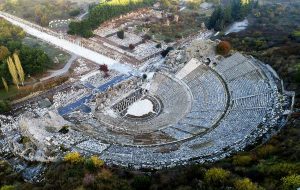The Riot in Ephesus

The riot in Ephesus described in Acts 19 is one of dramatic stories in the New Testament. To understand how and why it started, we should know a bit about the city’s goddess – Artemis.
Ephesus was a very well positioned city, at crossroads of the Mediterranean. Wealthy kings and aristocrats knew how well protected the Artemis sanctuary was, and they started to deposit their wealth there, under the protection of the goddess. Even regular people were bringing offerings to the temple, so over time, it evolved into one of the earliest banks in the world, that became known as the Bank of Asia and survived from the 7th century BC to the 4th century AD. The access to great wealth is probably the secret of Artemis cult’s longevity. For the Ephesias, Artemis was not only their main goddess, but also a source of good income.
Demetrius, a wealthy silversmith from Ephesus, organised a riot against Paul and his missionary companions (Acts 19:23-41). As he knew very well tradional values and fears of Ephesians, he could easily be sucessful with his rhetoric. He described the preaching of Paul and his associates as a threat to the wealth and prestige of the great temple of Diana or Artemis, one of the Seven Wonders of the World. Of course, more than anythings else, it was also a threat to the income of local silversmiths, who were selling silver shrines and figurines of the goddess to the pilgrims who were visiting the temple. Paul’s teaching that “they be no gods, which are made with hands” (Acts 19:26) represented a big danger for them. Demetrius’ enraged audience “ran into the street”, shouting “Great is Artemis of the Ephesians” and rushing into the theater. Other people, without even understanding what was happening, joined the mob, dragging along with them Paul’s companions Gaius and Aristarchus.
So, what do we know about the silversmiths of Ephesus?
 In 1984 a monument was discovered in Ephesus, in the street that connects the theater with the ancient stadium. Dating to the late 2nd or early 3rd century, the monument was dedicated to the proconsul Valerius Festus by the guild of Ephesian silversmiths — the group that, more than a century before, had organised the riot against Paul. They wanted to show appreciation to their benefactor for his work on the harbour. The inscription on the monument reads:
In 1984 a monument was discovered in Ephesus, in the street that connects the theater with the ancient stadium. Dating to the late 2nd or early 3rd century, the monument was dedicated to the proconsul Valerius Festus by the guild of Ephesian silversmiths — the group that, more than a century before, had organised the riot against Paul. They wanted to show appreciation to their benefactor for his work on the harbour. The inscription on the monument reads:
“To good fortune. The silversmiths (argyrochooi) of the first and greatest metropolis of the Ephesians in Asia – thrice temple-warden of the Augusti – set this up for Valerius Festus, the proconsul (anthypatos) descended from proconsuls, founder of many works in Asia and in Ephesos after the passing of Antoninus, who enlarged (or: enhanced) the harbor of Croesus. He was their own savior and benefactor in everything”.
The inscription on the monument contains some words similar to the words used in Acts. For example, in Acts 19:35, the “townclerk” describes Ephesus as the worshiper of the goddess Artemis (Diana), using a Greek term (“neokoros”), almost unique to Ephesus, that also appears in the silversmiths’ inscription.
You can read more about Artemis here:
https://ertungaecir.com/blog/the-temple-of-artemis-in-ephesus/
